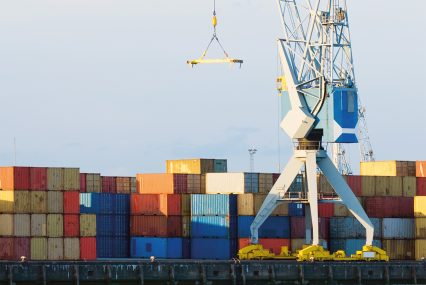
Regulatory push on the banking sector has swung the pendulum in favour of trading houses, which are now the risk-takers and winners in commodity trade financing. But how prudent is it to delegate the flow of the world’s primary goods among only a small set of companies? Aleya Begum reports.
Increasing policy and regulatory requirements are making banks shy away from funding commodity trade. With Basel III requirements barely nearing implementation, there are already talks of Basel III reconciled, or Basel IV, as dubbed by the banking sector. Add to that evolving and unclear sanctions policies, weak commodities prices, a frail global economy, major shifts in the global political sphere and what do you get? Uncertainty on all fronts. But while the banks are busy “de-risking” in an attempt to counter these unknowns, trading houses are stepping in to fill the shortfall.
Mis-leveraged leverage ratio
One of the primary challenges that banks’ commodity teams are facing is the leverage ratio. Part of the Basel framework, the ratio focuses on return on assets (ROA). Since commodity trade finance is a low-risk, low-reward, but big-volume business, its ROA is not particularly impressive. What the leverage ratio fails to do is factor in the low-risk assurance of the transaction, and therefore, compared to other bank activity, trade and commodity trade finance pale in comparison.
“You get a better return for a worse risk, so rather counterintuitively, the leverage ratio, which is meant to make banks less leveraged and more safe, steers banks away from low-risk business as everyone within the bank competes to use the same balance sheet. Trade finance in general has been hit quite hard by this,” says Deutsche Bank’s global head of structured commodity trade finance John MacNamara.
As well as the leverage ratio, the Basel framework also requires banks to have a certain amount of capital reserved for safekeeping. This means that there is less money in the pot compared to before. Outside of Basel, anti-money laundering (AML) and know your customer (KYC) regulations are also compounding the situation. Lead times for getting new clients and transactions onboard are longer due to higher thresholds.
“Regulatory pressure, capital requirements and an unco-ordinated push for more transparency and fight against capital crime is creating a very uncomfortable environment for the banking industry these days,” says founder and managing partner at Lambert Commodities, Jean-Francois Lambert. “Banks are now constantly reassessing the profitability or the worthiness of their lending activities and do not hesitate to exit a business which does not provide the required level of return or is raising any reputational concern.”
The knock-on effect of this has been less funding availability, especially for producers and the smaller trading companies.
“Over the past couple of years, all the facilities put in place by the banks have generally decreased, especially for the second-tier and third-tier type of trading companies,” says Olivier Boujol, director and global head of structured trade finance at Archer Daniels Midland (ADM). Many are now exclusively focusing on the large corporates, he adds.
The “nimble” trader
As the banks struggle to cope with the burden of compliance, larger trading houses have stepped in to fill the gap in the market. While they are exposed to the same governance regulations, traders are not subject to the same capital, leverage and liquidation requirements as the banks. Also working in their favour is the prevailing low price of commodities, which reduces working capital needs. So unlike the bankers, trading houses find themselves in a less constrained and favourably cash-rich position.
“Large corporates like ADM or Bunge don’t need bank facilities, which are usually used as more of a backstop than the real line that we draw under. We have a lot of cash so we don’t really need much financing these days,” says Boujol.
Banks are increasingly being seen as “slow” says Olivier Bazin, partner at law firm Holman Fenwick Willan (HFW). “So who’s stepping in? The more nimble trader. They have taken on some of the traditional roles of the banks. Structured finance teams and traders in [for example] Mercuria, Trafigura: they’re all ex-bankers. They will arrange the deal and either fund it themselves or offer it to banks. There are traders who now make more money out of providing finance than actually buying the product.”
The bigger trading houses also have the luxury of larger risk and compliance departments, while most commodity trade finance teams in banks are much more modest. With a number of fraud cases scarring some banks over the last few years, many are now happier to limit their exposure to the trader, who then on-lends to smaller traders and producers.
“The big traders these days have a lot of governance. They have compliance departments, often measured in hundreds, and rules and regulations they comply with. This makes it easier for the banks to lend directly to the trader,” says MacNamara.
“Ten years ago we were doing a lot of pre-export finance where we lent directly to producers who would sell to a range of traders. Now we’re lending to the traders and the traders are on-lending to the producers. I think the landmark deal at the tipping point between PXF and prepayment financing was probably in 2013 when Glencore and Vitol did the jumbo prepayment financing for [the long-term purchase of crude oil from] Rosneft.”
Deutsche Bank has done some classical syndicated PXF this year, but they are increasingly rare, he adds.
While the new structure in commodity trade financing is certainly lucrative for traders, Boujol at ADM argues that it’s not just about the money.
“You want to make sure your producers are being financed and have access to some form of financing because you want them to deliver. When you finance a longer supply chain, whether you finance the producers or the customers, it’s really just about making sure that you don’t interrupt the chain – that’s the main criteria,” he says. “We do make a little bit of money out of it but I would say that it’s not the primary motivation.”
Funds come knocking
Since the financial crisis in 2008, there has also been a notable interest in commodity trade finance from investment funds. Branded as ‘alternative financiers’, these funds started to take an interest when trade finance remained stable despite the collapse around it. The trouble was, at the time, the funds were looking for significantly higher returns than what is typical in low-margined trade finance. Those expectations were soon adjusted.
“When the funds first started knocking on the doors on the back of the global financial crisis, they were looking for returns of 15% to 20%. Nobody pays that in trade finance. As returns everywhere became lower, and interest rates hit rock bottom, target rates went down,” says MacNamara. “More recently they have begun targeting down to 5%, 4% and even 3%. So now there is more [alternative finance], but I wouldn’t overstate it. They are not in the same league as say Glencore, Vitol or Trafigura.”
According to Atanas Djumaliev, head of global commodities at VTB Capital, alternative trade finance funds are estimated to have less than US$10bn in assets collectively against over US$2tn of bank-intermediated trade finance. Furthermore, they tend to lend to smaller trading houses or manufacturers for secured claims with no more than 180 days’ maturity, rather than to major traders.
While they may not be playing in the big league, Boujol points out that some of the funds entering the game have hit a sweet spot. With SMEs struggling to access financing, especially in emerging markets, some of these funds have found a real niche, he says.
Also carving out an increasingly significant role in the commodity financing space are the insurance companies, which have become gradually more present in credit underwriting and providing credit coverage.
“I think that market has really been exponential [in terms of growth] in the past five or six years and we see more and more large trading houses building credit portfolios with insurance cover, to the extent they can deleverage their balance sheet in selling those assets to banks on an insurance cover basis,” says Boujol. “They have a lot of appetite to create finance for commodity flows and we and others have been deploying the insurance market pretty aggressively over the past few years.”
Lasting trend?
The question now is whether the banks will withdraw further from funding commodity trade or whether the pendulum will swing back in their favour. The changing face of regulation could see traders having to comply by the same capital rules, and if commodity prices pick up, their everyday business will become more expensive.
“It’s hard to predict but I would say it is probably for the long term. No company other than trading companies understand the ‘just in time’ nature of producers,” says Boujol at ADM. “Their activity is tied up to our future or existing contracts: it’s people that we know, people that we conduct business with. We can convince the underwriters to cover the credit risk, we can convince the banks who are then more willing to enter with financing. I think we are well-placed to offer that type of service.”
But a scenario where commodity trade financing becomes exclusively the responsibility of trading houses is a compromising one, believes Lambert at Lambert Commoditites. He warns that the lack of understanding of the strategic importance of commodity trade finance among industry and regulators needs to be addressed.
“Commodity trade flows make up some 25% of world trade and represent around US$4.5tn. Most of this trade is orchestrated by trading houses. Yet how many companies are we talking about? Maybe 20 to 50 large groups? We are relying on a handful of companies to support the bulk of the most strategic trade, which goes on to make up a majority of the remaining 75%,” he explains. “[But] regulators think that if it’s systematically important then it must be regulated more tightly. Trading houses don’t want to be more regulated so it’s a bit of a chicken and egg situation. This is the way the world is going right now.”
HFW’s Bazin expects to see a reoccurrence of trends witnessed in ship finance after 2008, when the traditional financiers moved out due to declining returns, paving the way for new players.
“I think we are going to see more investment trusts moving into the sector. That means more money around, which would create more competition and pressure for the banks, and prices could get cheaper,” he says.
Meanwhile, MacNamara believes the swinging pendulum is likely to be at the traders’ end for a while longer: “That’s not to say there is no business for the banks, just that more of that business is with the traders. I think both parties bring something to the table, whether it’s the bank or the trader, when they sit in front of a producer.”











